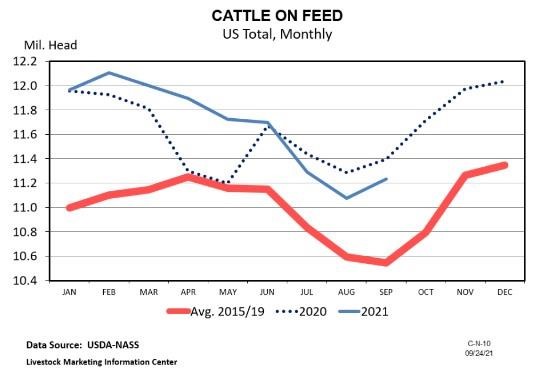By Kenny Burdine
The September Cattle on Feed report was released on Friday afternoon, September 24th. Monthly Cattle on Feed reports provide an estimate of cattle inventory in feedlots with one-time capacity over 1,000 head. Based on a mid-year comparison to total cattle on feed numbers from the July Cattle report, these monthly reports account for about 84% of total cattle of feed. The September 1 estimate came in just over 11.2 million, which was about 1.4% below the 2020 level. Cattle on feed inventory has been running below year-ago since July. A link to the full report can be found here.

Placements did tick upward for the month of August. This is normal, but the magnitude of the increase from July was larger than one would typically expect. August placements were 2% above 2020 after being quite a bit below last year for July. It’s hard to read too much into this given how strange 2020 was. I also think it is very likely that drought conditions in much of the country forced some early sales of cattle into the feedlot sector. The increase seemed to be more in the heavier weight groups, which is largely consistent with that narrative. Marketings were virtually unchanged from 2020 to 2021, although they were about 3.5% below 2019.
From my perspective, the September Cattle on Feed report continues to confirm that we have turned the corner on feedlot inventory and numbers should be generally trending downward over the next few years. Certainly, this is positive news for an industry that has struggled with packing capacity recently. But, I also think it is important to note that feedlot inventory, while trending downward, is still relatively high. Note in the chart above that while current inventory is below 2020, it is well above the 5-year average. As an example, the September 2021 number is still 2.2% higher than September 2019.
After expanding from 2014-2018, the US Beef cow herd reached a high in 2019. Since then, we have seen two years of declining beef cow numbers. Given drought conditions in much of the US and beef cow slaughter thus far in 2021, I think there is no question that this will be another year of contraction. The contracting beef cow herd and shrinking calf crops will lead to smaller numbers of cattle to be finished over the next several years. But it is important to understand that due to the time lag between calf crops and the placement of those calf crops on feed, and the pandemic related issues seen in 2020, we are just now starting to see the impacts of beef herd liquidation in these Cattle on Feed reports.
Source : osu.edu